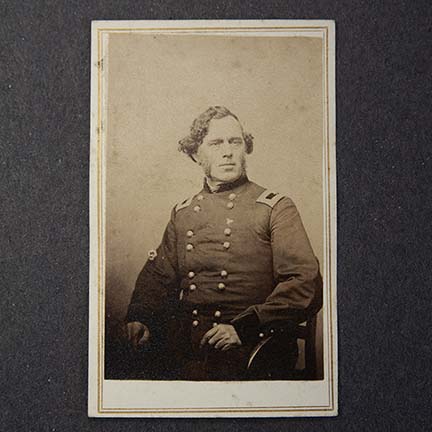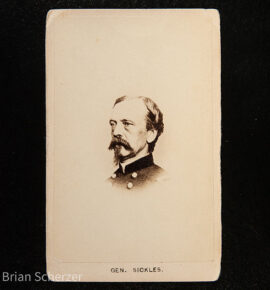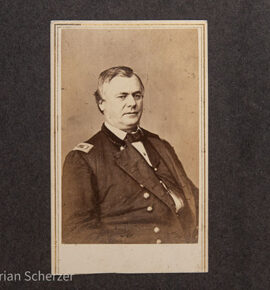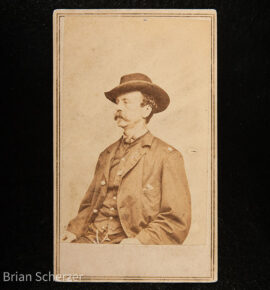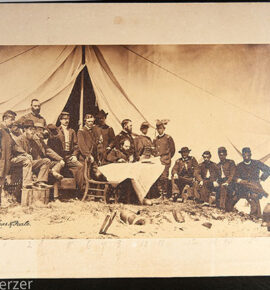Description
The cdv of Steedman has a backmark by Morse's Gallery of the Cumberland. Steedman raised and was elected colonel of the 14th Ohio Infantry Regiment on April 27, 1861 and was appointed a regular army colonel of the 14th Ohio on September 1, shortly after the regiment re-enlisted for three years. Steedman and the 14th first saw action in June during the Union victory at the Battle of Philippi in Barbour County, Virginia (now part of West Virginia). Steedman and his regiment were then sent to serve in the Western Theater. They took part in Union victory during the Battle of Mill Springs in January 1862. The 14th Ohio also participated in the Siege of Corinth in late April and early June. Steedman was promoted to the rank of brigadier general on July 17, 1862 and given brigade command in the Army of the Ohio.
Following the Union victory at the Battle of Shiloh in April 1862, Steedman and his brigade were sent to join Maj. Gen. Don Carlos Buell's army in Kentucky that fall. During the Battle of Perryville on October 8, his brigade reinforced Brig. Gen. Rousseau's division, timely filling a gap in the Union line and saving the division from being pushed from the field. Steedman would receive a high commendation from Buell in his official report of the battle.
Steedman and his brigade fought during the Battle of Stones River in December 1862 and into January 1863, with his command a part of Brig. Gen. Speed S. Fry's division of the renamed Army of the Cumberland, now under the command of Maj. Gen. William S. Rosecrans. During the Battle of Chickamauga in the fall of 1863, Steedman led the vanguard of Union Maj. Gen. Gordon Granger's Reserve Corps to Maj. Gen. George Henry Thomas' aid on September 20. From his position north of the battlefield at MacAfee's Church, Granger heard the sounds of the fight to the south. Without orders from Rosecrans, Granger sent Steedman's brigade to support Thomas' last-ditch defensive effort as the rest of Rosecrans' defeated army raced for Chattanooga, Tennessee.
Steedman moved quickly and arrived about 2:30 p.m., just in time to stop Confederate Lt. Gen. James Longstreet's attempt to turn Thomas's right. Steedman is credited with "performing the most conspicuous act of personal courage recorded by any army officer during the Battle of Chickamauga" and preventing Rosecrans' defeat turning into a Union "disaster." Military historian Ezra J. Warner stated that "His heroism was virtually the salvation of the Union forces left on the field" at Chickamauga. During the fight, Steedman was wounded when his horse was shot and killed under him.
In late 1863, Steedman participated in the Siege of Chattanooga, as well as the Third Battle of Chattanooga from November 23–25. He remained in Chattanooga, commanding all forces there until May 1864, during which he was promoted to the rank of major general on April 20. Steedman also participated in much of the Atlanta Campaign, and then commanded the District of Etowah in the Department of the Cumberland from June 15 to November 29, and again from January 5, 1865.
In between his stints of district command, Steedman fought with Thomas' army during the Battle of Nashville on December 15–16, 1864. At Nashville Steedman led a "provisional" division consisting of 11 regiments on the Union left. He had arrived over two days from Chattanooga by rail with about 6,000 men, a collection of his own brigade plus men returning from furlough but belonging to other units. Steedman would be the only non-West Point graduate of Thomas' six chief commanders at Nashville.
Thomas ordered Steedman and his three-brigade division to make a diversionary attack at 6 a.m. on December 15, thereby keeping the Confederate Army of Tennessee's right (the corps of Maj. Gen. Benjamin F. Cheatham) occupied all day and preventing them from aiding against the main assault elsewhere. The orders were later modified to say if his diversion could be made into a successful attack, then Steedman should do so. On December 16, Thomas ordered an attack by the corps of Maj. Gen. Thomas J. Wood (along with Steedman's men) against the right of the Army of Tennessee, now held by Maj. Gen. Stephen D. Lee's corps. At noon the attack was begun, but initially was without success. Steedman's men took heavy losses in the first assaults this day, including one of his regiments, the 13th USCT Infantry, losing 221 men, the most of any regiment that day, Union or Confederate. When the rest of Thomas' force finally broke through Cheatham's men on the left as well as the Confederate center at 4 p.m., Wood and Steedman renewed their attack and helped the rest of Thomas' army overwhelm Lee's corps, driving it from the field.
After the Battle of Nashville, Steedman returned to Etowah until he was given command of the Department of Georgia, an assignment lasting from June 27 to December 10, 1865. He remained in the Army after the end of the American Civil War until resigning on August 18, 1866.

